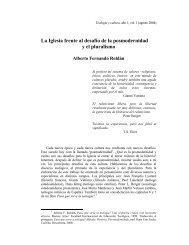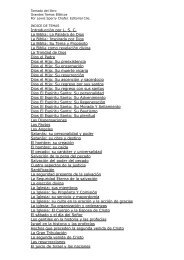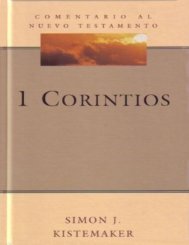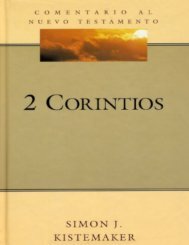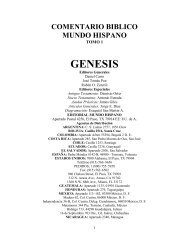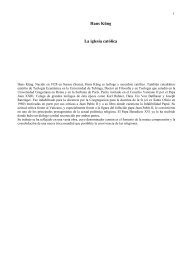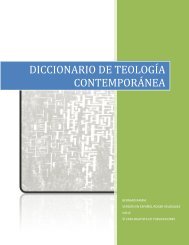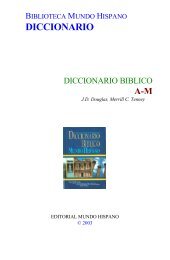Moon-o-theism: Religion of a War- and Moon-god Prophet
Moon-o-theism: Religion of a War- and Moon-god Prophet
Moon-o-theism: Religion of a War- and Moon-god Prophet
- No tags were found...
Create successful ePaper yourself
Turn your PDF publications into a flip-book with our unique Google optimized e-Paper software.
<strong>Moon</strong>-o-<strong>theism</strong> by Yoel Natan 345 People in ancient times knew that lions are nocturnal hunters especially on moonlitnights, so naturally they associated the lion with the moon-<strong>god</strong>: In the Gilgamesh Epic, Gilgamesh prayed to Sin the moon-<strong>god</strong> for help infending <strong>of</strong>f lions at night. 1885 At Hazor’s moon-<strong>god</strong> temple, a lion orthostat guarded the entrance. 1886 At the moon-<strong>god</strong> temple in Marib a bronze statue dedicated to Almaqahwears a moon-<strong>god</strong> approved curved knife under his belt <strong>and</strong> a lion-skin capeas shown by the four paws. 1887Archaeologists discussing a cherub riding a lion statue found at Timna, capital <strong>of</strong>Kataban in southwest Yemen, note that this was a popular ancient statue motif that, atleast in Timna, would have represented the moon-<strong>god</strong> controlling the sun. BertaSegall wrote that the cherub riding a lion motif……outside Arabia, indicates a supremacy <strong>of</strong> the divinity <strong>of</strong> the night-sky overthat <strong>of</strong> the sky <strong>of</strong> the day, is possibly a sign that they meant to emphasize theirspecial loyalty to the Arabian male <strong>god</strong> <strong>of</strong> the heavens. In Babylon the moon-<strong>god</strong>had from very ancient times ‘renewed the royal seed to distant days’ <strong>and</strong> wastherefore the divinity <strong>of</strong> rulers <strong>and</strong> the ruling class <strong>and</strong>, in a wider sense, the‘life-index’ the index to health <strong>and</strong> prosperity, <strong>of</strong> the ruled, as W.F. Albrightsuggested. 1888In the case <strong>of</strong> Timna, though, this statue may in fact represent a moon-<strong>god</strong>controlling a lunar animal, since the lion in the Mideast may have been a lunaranimal more than a solar animal.Revisionists cite classical Greek <strong>and</strong> Roman writers to support their theory inseveral points. For instance, a Greek historian Theophrastes <strong>of</strong> Eresos (372-287 BC)wrote that frankincense was collected in a Sabean temple <strong>of</strong> the sun even though hemeant a Hadramawt temple hundreds <strong>of</strong> miles to the east. 1889 Breton says thissuggests that the Hadramawt Syn was a sun-<strong>god</strong>, though Theophrastes’ geographymistake suggests that Theophrastes was just hazarding a guess. Theophrastes madeother mistakes such as he thought cinnamon was grown in South Arabia rather thanin India. 1890 Lastly, Theophrastes could have had in mind the temple <strong>of</strong> theHadramawt sun <strong>god</strong>dess dhat-Himyam.Theophrastes’ information implies that Syn would have been a sun-<strong>god</strong> if histemple was meant, except that Theophrastes probably just assumed that theHadramawts’ national <strong>god</strong> was a sun-<strong>god</strong> based on Mediterranean mythology. Thismistake is similar to how Greek travelers thought the Abyssinian moon-<strong>god</strong> Mahremwas the <strong>god</strong> <strong>of</strong> Mars (Ares) 1891 on account <strong>of</strong> Mahram’s male gender <strong>and</strong> hispreoccupation with war-making. After all, Greek moon-<strong>god</strong>s were female <strong>and</strong> wereinvolved in hunting but not warfare.1885 Anonymous. Gilgamesh, “The Search for Everlasting Life.” Also, Pritchard. Ancient, I:62,middle <strong>of</strong> Tablet IX.1886 Yadin, Yigael. Hazor: The Rediscovery Of A Great Citadel Of The Bible. Weidenfield <strong>and</strong>Nicolson, London & Jerusalem, 1975, pp. 44-47.1887 Phillips. Sheba, p. 287.1888 Segal, Berta. “The Lion-riders from Timna,” Bowen & Albright. Arabia, pp. 163-164.1889 Breton. Felix, p. 122. Theophrastus’ Natural History, 9.4.5.1890 Breton. Felix, pp. 54, 61.1891 Nielsen, 1912, pp. 593-594, as translated in Krause, “Haram–Harimat.”



